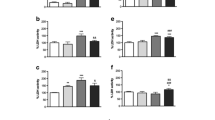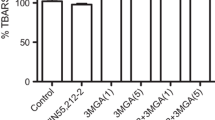Abstract
The mechanisms by which the heavy metal thallium (Tl+) produces toxicity in the brain remain unclear. Herein, isolated synaptosomal/mitochondrial P2 crude fractions from adult rat brains were exposed to Tl+ (5–250 μM) for 30 min. Three toxic endpoints were evaluated: mitochondrial dysfunction, lipid peroxidation, and Na+/K+-ATPase activity inhibition. Concentration-response curves for two of these endpoints revealed the optimum concentration of Tl+ to induce damage in this preparation, 5 μM. Toxic markers were also estimated in preconditioned synaptosomes incubated in the presence of the N-methyl-d-aspartate receptor antagonist kynurenic acid (KYNA, 50 μM), the cannabinoid receptor agonist WIN 55,212-2 (1 μM), or the antioxidant S-allyl-L-cysteine (SAC, 100 μM). All these agents prevented Tl+ toxicity, though SAC did it with lower efficacy. Our results suggest that energy depletion, oxidative damage, and Na+/K+-ATPase activity inhibition account for the toxic pattern elicited by Tl+ in nerve terminals. In addition, the efficacy of the drugs employed against Tl+ toxicity supports an active role of excitatory/cannabinoid and oxidative components in the toxic pattern elicited by the metal.


Similar content being viewed by others
References
Bhat AH, Dar KB, Anees S, Zargar MA, Masood A, Sofi MA, Ganie SA (2015) Oxidative stress, mitochondrial dysfunction and neurodegenerative diseases; a mechanistic insight. Biomed Pharmacother 74:101–110. https://doi.org/10.1016/j.biopha.2015.07.025
Blain R, Kazantzis G (2015) Thallium. In: Nordberg GF, Fowler BA, Nordberg M (eds) Handbook on the Toxicology of Metals. Volume II: Specific Metals. Elsevier, Amsterdam, pp 1229–1240
Chan KM, Delfert D, Junger KD (1986) A direct colorimetric assay for Ca2+-stimulated ATPase activity. Anal Biochem 157(2):375–380. https://doi.org/10.1016/0003-2697(86)90640-8
Colín-González AL, Ali SF, Túnez I, Santamaría A (2015) On the antioxidant, neuroprotective and anti-inflammatory properties of S-allyl cysteine: an update. Neurochem Int 89:83–91. https://doi.org/10.1016/j.neuint.2015.06.011
Colín-González AL, Paz-Loyola AL, de Lima ME, Galván-Arzate S, Seminotti B, Ribeiro CA, Leipnitz G, Souza DO, Wajner M, Santamaría A (2016) Experimental evidence that 3-methylglutaric acid disturbs mitochondrial function and induced oxidative stress in rat brain synaptosomes: new converging mechanisms. Neurochem Res 41(10):2619–2626. https://doi.org/10.1007/s11064-016-1973-2
Eskandari MR, Mashayekhi V, Aslani M, Hosseini MJ (2015) Toxicity of thallium on isolated rat liver mitochondria: the role of oxidative stress and MPT pore opening. Environ Toxicol 30(2):232–241. https://doi.org/10.1002/tox.21900
Favari L, Mourelle M (1985) Thallium replaces potassium in activation of the (Na+,K+)-ATPase of rat liver plasma membranes. J Appl Toxicol 5(1):32–34. https://doi.org/10.1002/jat.2550050106
Fischer R, Maier O (2015) Interrelation of oxidative stress and inflammation in neurodegenerative disease: role of TNF. Oxidative Med Cell Longev 2015:610813
Galván-Arzate S, Santamaría A (1998) Thallium toxicity. Toxicol Lett 99(1):1–13. https://doi.org/10.1016/S0378-4274(98)00126-X
Galván-Arzate S, Pedraza-Chaverrí J, Medina-Campos ON, Maldonado PD, Vázquez-Román B, Ríos C, Santamaría A (2005) Delayed effects of thallium in the rat brain: regional changes in lipid peroxidation and behavioral markers, but moderate alterations in antioxidants, after a single administration. Food Chem Toxicol 43(7):1037–1045. https://doi.org/10.1016/j.fct.2005.02.006
Hanzel CE, Verstraeten SV (2006) Thallium induces hydrogen peroxide generation by impairing mitochondrial function. Toxicol Appl Pharmacol 216(3):485–492. https://doi.org/10.1016/j.taap.2006.07.003
Hanzel CE, Verstraeten SV (2009) Tl (I) and Tl (III) activate both mitochondrial and extrinsic pathways of apoptosis in rat pheochromocytoma (PC12) cells. Toxicol Appl Pharmacol 236(1):59–70. https://doi.org/10.1016/j.taap.2008.12.029
Herman MM, Bensch KG (1967) Light and electron microscopic studies of acute and chronic thallium intoxication in rats. Toxicol Appl Pharmacol 10(2):199–222. https://doi.org/10.1016/0041-008X(67)90104-4
Hong L, Xiang-Lin Y, Ying W, Xiao-Qiao T, Dong-Ying J, Hui-Bi X (2003) Protective effects of scutellarin on superoxide-induced oxidative stress in rat cortical synaptosomes. Acta Pharmacol Sin 24:1113–1117
Korotkov SM (2009) Effects of Tl+ on ion permeability, membrane potential and respiration of isolated rat liver mitochondria. J Bioenerg Biomembr 41(3):277–287. https://doi.org/10.1007/s10863-009-9225-7
Korotkov SM, Brailovskaya IV, Kormilitsyn BN, Furaev VV (2014) Tl+ showed negligible interaction with inner membrane sulfhydryl groups of rat liver mitochondria, but formed complexes with matrix proteins. J Biochem Mol Toxicol 28(4):149–156. https://doi.org/10.1002/jbt.21547
Korotkov SM, Emelyanova LV, Konovalova SA, Brailovskaya IV (2015) Tl+ induces the permeability transition pore in Ca2+-loaded rat liver mitochondria energized by glutamate and malate. Toxicol. In Vitro 29:1034–1041
Lowry OH, Rosebrough NJ, Farr AL, Randall RJ (1951) Protein measurement with the Folin phenol reagent. J Biol Chem 193(1):265–275
Maya-López M, Colín-González AL, Aguilera G, de Lima ME, Colpo-Ceolin A, Rangel-López E, Villeda-Hernández J, Rembao-Bojórquez D, Túnez I, Luna-López A, Lazzarini-Lechuga R, González-Puertos VY, Posadas-Rodríguez P, Silva-Palacios A, Königsberg M, Santamaría A (2017) Neuroprotective effect of WIN55,212-2 against 3-nitropropionic acid-induced toxicity in the rat brain: involvement of CB1 and NMDA receptors. Am J Transl Res 9(2):261–274
Melnick RL, Monti LG, Motzkin SM (1976) Uncoupling of mitochondrial oxidative phosphorylation by thallium. Biochem Biophys Res Commun 69(1):68–73. https://doi.org/10.1016/S0006-291X(76)80273-2
Mulkey JP, Oehme FW (1993) A review of thallium toxicity. Vet Hum Toxicol 35(5):445–453
Osorio-Rico L, Villeda-Hernández J, Santamaría A, Königsberg M, Galván-Arzate S (2015) The N-methyl-D-aspartate receptor antagonist MK-801 prevents thallium-induced behavioral and biochemical alterations in the rat brain. Int J Toxicol 34(6):505–513. https://doi.org/10.1177/1091581815603936
Osorio-Rico L, Santamaria A, Galván-Arzate S (2017) Thallium toxicity: general issues, neurological symptoms, and neurotoxic mechanisms. Adv Neurobiol 18:345–353. https://doi.org/10.1007/978-3-319-60189-2_17
Pino MT, Marotte C, Verstraeten SV (2017) Epidermal growth factor prevents thallium(I)- and thallium(III)-mediated rat pheochromocytoma (PC12) cell apoptosis. Arch Toxicol 91(3):1157–1174. https://doi.org/10.1007/s00204-016-1793-9
Pourahmad J, Eskandari MR, Daraei B (2010) A comparison of hepatocyte cytotoxic mechanisms for thallium (I) and thallium (III). Environ Toxicol 25(5):456–467. https://doi.org/10.1002/tox.20590
Puga Molina LC, Salvatierra Fréchou DM, Verstraeten SV (2017) Early response of glutathione- and thioredoxin-dependent antioxidant defense systems to Tl(I)- and Tl(III)-mediated oxidative stress in adherent pheochromocytoma (PC12adh) cells. Arch Toxicol. https://doi.org/10.1007/s00204-017-2056-0
Rangel-López E, Colín-González AL, Paz-Loyola AL, Pinzón E, Torres I, Serratos IN, Castellanos P, Wajner M, Souza DO, Santamaría A (2015) Cannabinoid receptor agonists reduce the short-term mitochondrial dysfunction and oxidative stress linked to excitotoxicity in the rat brain. Neuroscience 285:97–106. https://doi.org/10.1016/j.neuroscience.2014.11.016
Sánchez-Blázquez P, Rodríguez-Muñoz M, Garzón J (2014) The cannabinoid receptor 1 associates with NMDA receptors to produce glutamatergic hypofunction: implications in psychosis and schizophrenia. Front Pharmacol 4:169
Tao Z, Gameiro A, Grewer C (2008) Thallium ions can replace both sodium and potassium ions in the glutamate transporter EAAAC1. Biochemist 47(48):12923–12930. https://doi.org/10.1021/bi8017174
Verstraeten SV (2006) Relationship between thallium (I)-mediated plasma membrane fluidification and cell oxidants production in Jurkat T cells. Toxicology 222(1-2):95–102. https://doi.org/10.1016/j.tox.2006.01.028
Villaverde MS, Hanzel CE, Verstraeten SV (2004) In vitro interactions of thallium with components of glutathione-dependent antioxidant defense system. Free Radic Res 38(9):977–984. https://doi.org/10.1080/10715760400000950
Yoshida J, Shigemura A, Ogino Y, Denbow DM, Furuse M (2013) Two receptors are involved in the central functions of kynurenic acid under an acute stress in neonatal chicks. Neuroscience 248:194–200. https://doi.org/10.1016/j.neuroscience.2013.06.005
Funding
This work was supported by CONACyT Grant 205648 (A.S.).
Author information
Authors and Affiliations
Corresponding author
Ethics declarations
All experiments were carried out following the criteria stated in the “Guidelines for the Use of Animals in Neuroscience Research” from the Society of Neuroscience, the local Bioethics Committees, and in compliance with the ARRIVE guidelines.
Conflict of Interest
The authors declare that they have no conflict of interest.
Rights and permissions
About this article
Cite this article
Maya-López, M., Mireles-García, M.V., Ramírez-Toledo, M. et al. Thallium-Induced Toxicity in Rat Brain Crude Synaptosomal/Mitochondrial Fractions is Sensitive to Anti-excitatory and Antioxidant Agents. Neurotox Res 33, 634–640 (2018). https://doi.org/10.1007/s12640-017-9863-1
Received:
Revised:
Accepted:
Published:
Issue Date:
DOI: https://doi.org/10.1007/s12640-017-9863-1




